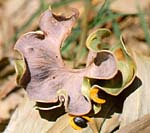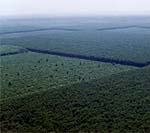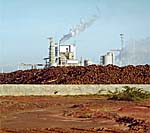|
|
|
|
Wood is the major biomass energy source for millions of people in developing countries, and the demand is increasing as populations grow (Thomson et al., 1994). Acacias have good biomass production potential and the wood is generally considered to be a good fuel with a high calorific value. Considerable work has been undertaken in recent years to explore this potential in overseas countries, to address pressing issues of both fuel shortages and land degradation. The Australian Centre for International Agricultural Research (ACIAR) has supported research involving many Australian acacias with fuelwood and other multi-purpose potential abroad (see Turnbull, 1986, 1987, 1991; Boland, 1989; Doran & Turnbull, 1997; and Turnbull et al., 1998b). The success of Australian Acacia species in this role is partly due to their ability to thrive under adverse conditions. For example, the tropical arid-zone species A. ampliceps (Salt Wattle), A. maconochieana (Mullan Wattle) and A. stenophylla (Eumong) are tolerant of highly alkaline, saline soils and have performed successfully on similar soil types in Pakistan where they are used as a source of fuelwood (Marcar et al., 1991). Thomson et al. (1994) documented the attributes of 125 species of Australian tropical arid-zone acacias that have potential for multipurpose use in drought-affected regions such as the Sahel, West Africa.
Acacia mangium (Mangium) is the most commercially important and widely planted tropical acacia (Turnbull et al., 1998a). Large plantations have been established, mainly in Indonesia and Malaysia, to supply woodchips for paper pulp. Its wood is also used in this region for building and furniture timber, the manufacture of reconstituted wood and for fuelwood. In Australia, plantations of A. mangium have recently been established on the Tiwi Islands, Northern Territory, for paper pulp production. Acacia auriculiformis (Northern Black Wattle) is also widely planted in the Asia-Pacific region, mainly for fuelwood and amenity. Hybrid A. auriculiformis × mangium have shown outstanding growth potential in this region, coupled with excellent wood properties (Pinso & Nasi, 1991; Kha, 1996). In recent years, A. crassicarpa (Thick-podded Salwood) and A. peregrina (New Guinea Salwood) (formerly considered A. aulacocarpa) have also assumed importance for the production of sawn timber and paper pulp in the Asia-Pacific region (Thomson, 1994; Turnbull et al., 1998b; McDonald & Maslin, 2000).
Acacia mearnsii (Black Wattle) is the most commercially important and widely planted temperate acacia, with major plantations established in Brazil, the Republic of South Africa and east Africa (Turnbull et al., 1998a). Although historically planted for its tannin-rich bark, its wood is also used for paper pulp, cellulose for rayon, charcoal and round timber. In Australia Black Wattle, along with its relative A. dealbata (Silver Wattle), is sometimes harvested from natural stands for paper pulp (Logan, 1987).
Acacia melanoxylon (Blackwood) is the best known and most highly valued temperate acacia timber species. In Australia, the most significant commercial harvesting of Blackwood is from natural stands in Tasmania, while plantation-grown timber is produced mainly in New Zealand, South Africa and Chile. Blackwood timber is mainly used for construction and furniture (solid wood and veneer). In recent years, commercial plantations of Blackwood for timber production have been established in Australia (e.g. Neilsen et al., 1998). Another timber species harvested from natural stands in Australia is A. celsa (Brown Salwood) in north-eastern Queensland (under the name of A. aulacocarpa); its wood has been used for construction purposes, furniture and woodcraft items (Boland et al., 1984; Bootle, 1983). Wood from natural stands of acacias has also been used for a range of specialty uses, for example A. aneura (Mulga) and A. carnei (Needle Wattle) have been used for handicrafts and wood-turning; species such as A. aneura, A. acuminata (Jam), A. cambagei (Gidgee), A. harpophylla (Brigalow), A. melvillei (Yarran), A. shirleyi (Lancewood) and A. tenuinervis (Scrub Wattle) have been used for fence posts and yard rails (e.g. Cunningham et al., 1981; Boland et al., 1984; Lithgow, 1997).
Native Acacias in the agricultural regions of southern Australia (250-650 mm rainfall zone) were recently assessed by the AcaciaSearch project for their potential as new woody crop plants. The impetus for this study was the need to undertake large-scale commercial plantings of perennial plants as a treatment for salinity within these regions. Emphasis was given to fast growing species with potential for producing large amounts of wood biomass that may find uses as solid and reconstituted wood products and for bioenergy, and which may contain commercially attractive by-products such as extractives (especially tannin and gum) and fodder.
References
Boland, D.J. (ed.) (1989), Trees for the Tropics. Growing Australian Multipurpose Trees and Shrubs in Developing Countries. ACIAR Monograph No. 10. Australian Centre for International Agricultural Research, Canberra.
Boland, D.J., Brooker, M.I.H., Chippendale, G.M., Hall, N., Hyland, B.P.M., Johnston, R.D., Kleinig, D.A. & Turner, J.D. (1984), Forest Trees of Australia. Nelson-CSIRO, Melbourne.
Bootle, K.R. (1983), Wood in Australia. Types, Properties and Uses. McGraw-Hill Book Company, Sydney.
Cunningham, G.M., Mulham, W.E., Milthorpe, P.L. & Leigh, J.H. (1981), Plants of Western New South Wales. Soil Conservation Service of New South Wales, Sydney.
Doran, J.C. & Turnbull, J.W. (1997), Australian Trees and Shrubs: Species for Land Rehabilitation and Farm Planting in the Tropics. ACIAR Monograph No. 24. Australian Centre for International Agricultural Research, Canberra.
Kha, L.D. (1996), Studies on natural hybrids of Acacia mangium and A. auriculiformis in Vietnam, in M.J.Deiters, A.C.Matheson, D.G.Nikles, C.E.Harwood & S.M.Walker (eds), Tree Improvement for Sustainable Tropical Forestry. Proceedings of QFRI-IUFRO Conference. 27 October-1 November 1996, Caloundra, Queensland, Australia, pp. 328-332. Queensland Forestry Research Institute, Gympie.
Lithgow, M.G. (1997), 60 wattles of the Chinchilla and Murilla Shires. Private publication. Chinchilla, Queensland.
Logan, A.F. (1987), Australian acacias for pulpwood, in J.W.Turnbull (ed.), Australian Acacias in Developing Countries. Proceedings of an International Workshop, Gympie, Qld, Australia, 4-7 August 1986. ACIAR Proceedings No. 16, pp. 89-94. Australian Centre for International Agricultural Research, Canberra.
Marcar, N.E., Hussain, R.W., Arunin, S. & Beeton, T. (1991), Trials of Australian and other Acacia species on salt-affected land in Pakistan, Thailand and Australia, in J.W.Turnbull (ed.). Advances in Tropical Acacia Research, ACIAR Proceedings No. 35, pp. 229-232. Australian Centre for International Agricultural Research, Canberra.
Maslin, B.R. and McDonald, M.W. (1996). A key to useful Australian acacias for the seasonally dry tropics. (CSIRO Forestry and Forest Products: Canberra.) This book may be purchased via the web from CSIRO Publishing.
McDonald, M.W. and Maslin, B.R. (1997) A reappraisal of Acacia cowleana and allied taxa, including the description of a new species, A. elachantha, from tropical dry-zone of Australia. Australian Systematic Botany 10: 303–320. An abstract of this paper is available from CSIRO Publishing.
McDonald, M.W. and Maslin, B.R. (2000). Taxonomic revision of the Salwoods: Acacia aulacocarpa Cunn. Ex Benth. and its allies (Leguminosae: Mimosoideae: section Juliflorae). Australian Systematic Botany 13: 21–78. An abstract of this paper is available from CSIRO Publishing.
Neilsen, W.A, Kube, P.D. & Elliot, H.J. (1998), Prospects for commercial plantations of Acacia melanoxylon and A. dealbata in Tasmania, in J.W.Turnbull, H.R.Crompton & K.Pinyopusarerk (eds), Recent Developments in Acacia Planting. Proceedings of an international workshop held in Hanoi, Vietnam, 27-30 October, 1997. ACIAR Proceedings No. 82, pp. 94-101. Australian Centre for International Agricultural Research, Canberra.
Pinso, C & Nasi, R. (1991), The potential of A. mangium × Acacia auriculiformis hybrid in Sabah, in L.T.Carron & K.M.Aken (eds). Breeding Technologies for Tropical Acacias. ACIAR Proceedings No. 37, pp. 17-21. Australian Centre for International Agricultural Research, Canberra.
Thomson, L.A.J. (1994), Acacia aulacocarpa, A. cincinnata, A. crassicarpa and A. wetarensis: an Annotated Bibliography. CSIRO Division of Forestry, Australian Tree Seed Centre: Canberra.
Thomson, L.A.J., Turnbull, J.W. & Maslin, B.R. (1994), The utilization of Australian species of Acacia, with particular reference to those of the subtropical dry zone, J. Arid Environm. 27: 279-295.
Turnbull, J.W. (ed.) (1986), Multipurpose Australian Trees and Shrubs. Lesser-known Species for Fuelwood and Agroforestry. ACIAR Monograph No. 1. Australian Centre for International Agricultural Research, Canberra. 316 p.
Turnbull, J.W. (ed.) (1987), Australian Acacias in Developing Countries. Proceedings of an international workshop held at the Forestry Training Centre, Gympie, Queensland Australia, 4-7 August 1986. ACIAR Proceedings No. 16. Australian Centre for International Agricultural Research, Canberra. 196 pp.
Turnbull, J.W. (1991), Advances in Tropical Acacia Research. Proceedings of a workshop held in Bangkok, Thailand, 11-15 February, 1991. ACIAR Proceedings No. 35, Australian Centre for International Agricultural Research, Canberra. 234 pp.
Turnbull, J.W., Midgley, S.J. & Cossaltar, C. (1998a), Tropical acacias planted in Asia: an overview, in J.W.Turnbull, H.R.Crompton & K.Pinyopusarerk (eds), Recent Developments in Acacia Planting. Proceedings of an international workshop held in Hanoi, Vietnam, 27-30 October, 1997. ACIAR Proceedings No. 82, pp. 29-35. Australian Centre for International Agricultural Research, Canberra.
Turnbull, J.W., Crompton, H.R. & Pinyopusarerk, K. (eds) (1998b), Recent Developments in Acacia Planting. Proceedings of the Third International Acacia Workshop, Hanoi, 27-31 Oct 1997. ACIAR Proceedings No. 82. Australian Centre for International Agricultural Research, Canberra. 383 pp.


